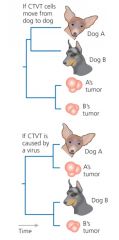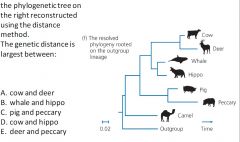![]()
![]()
![]()
Use LEFT and RIGHT arrow keys to navigate between flashcards;
Use UP and DOWN arrow keys to flip the card;
H to show hint;
A reads text to speech;
6 Cards in this Set
- Front
- Back
|
How can phylogenies be used? |
1. Classification of disease 2. How diseases propogate 3. Molecular dating 4. Historical biogeogrpaphy |
|
|
How many times has HIV transfered to humans independently? |
4 |
|
|
T/F: Group M HIV is more prevalant in humans |
True |
|

Explain the image |
The image depicts how phylogeny is able to determine how a disease propogates. Canine Transmissible Venereal Tumor (CTVT) is transmitted when dogs copulate with others creating tumors. However, it was not know if the tumors were caused by a virus or the cancer cells themselves. By performing a phylogeny, they were able to determine that the spread of the cancer from dog to dog was caused by the cancer cells themsevles and not a virus. This is becaue when comparing the DNA of the tumors found in dogs they found that tumor cells were more closely related to each other than that of the dog's cells indicating that the tumors didn't originate from the dog as you would expect from a virus. |
|
|
Explain how phylogeny was used to determine how Seychelles chameleon move across islnds or if the islands moved while the chameleons were there |
If the islands moved with the chameleons on them, then the chameleon phylogeny should reflect the history of the continents and islands. When comparing the island phylogeny and the chameleon phylogeny they found that the chameleon phylogeny was different from the island indicating that the chameleons traveled by sea to the islands. |
|

|
E. Deer and Peccary |

